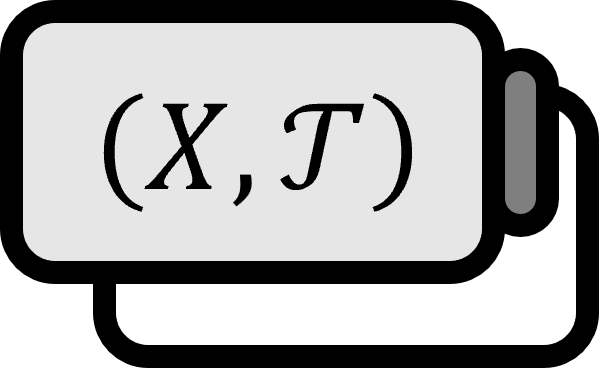Topological Spaces: Separability and Closure
Definition 1
For a topological space $X$, let’s say $A \subset X$.
- When an open set $O$ exists that satisfies $x \in O \subset A$, $x$ is called the interior point of $A$.
- The set of interior points of $A$, $A^{\circ}$, is called the interior of $A$.
- The union of $A$ and its codomain $\overline{A} : = A \cup a '$ is called the closure of $A$.
- When $x \in \overline{A}$ and also $x \in \overline{X \setminus A}$, $x$ is called the boundary point of $A$.
- $\partial A : = \overline{A} \cap \overline{X \setminus A}$ is called the boundary of $A$.
- When $\overline{A} = X$, $A$ is said to be dense in $X$.
- When $\left( \overline{A} \right) ^{\circ} = \emptyset$, $A$ is said to be nowhere dense in $X$.
- If $X$ has a dense countable subset, then $X$ is said to be separable.
- $\overline{A}$ and $A^{\circ}$ are the closure and interior of $A$, respectively.
Explanation
Let’s confirm that various definitions previously defined in metric spaces can also be brought over without any problems.
A typical example of a separable space is $\overline{ \mathbb{Q} } = \mathbb{R}$.
If the notion of a countable subset is difficult, one might first think of segmenting the real space $\mathbb{R}$ with the set of integers $\mathbb{Z}$. Although this imagery is easy to imagine, dividing any set into its subsets is easy and thus meaningless. Conversely, dividing it into uncountable subsets would be too chaotic to manage and ultimately meaningless. On the other hand, if there is a concept that satisfies both density and countability, as defined, it could be considered neither too simple nor too difficult. In such a case, the subset $A$, though referred to as a subset, must feel like a large ‘skeleton’ that supports the entire set.
Taking the metaphor of a skeleton a step further, saying that a space is a separable space essentially guarantees the existence of sequences $\left\{ x_{n} \right\}_{n \in \mathbb{N} }$ converging to $x$, for any given $x \in X$. For example, if $x \in \mathbb{R}$ is given, it means that we can find a sequence of rationals $\left\{ q_{n} \right\}_{n \in \mathbb{N}}$ that converge to $x$ no matter what $x$ is.
The importance of separability lies in it enabling us to create sequences (countable) that converge (dense) to the elements we desire. From a practical standpoint, the usefulness of this property becomes even more apparent. In applied mathematics, approximating some complex functions with well-known, simpler functions is undoubtedly crucial.
For instance, the space of continuous functions $C[a,b]$ is a separable space, which means we can find a sequence of continuous functions $\left\{ f_{n} \right\}_{n \in \mathbb{N}}$ that converge to any given $f$. Uncovering what exactly these $\left\{ f_{n} \right\}_{n \in \mathbb{N}}$ are is the responsibility of applied mathematics, such as numerical analysis, but proving their existence is the purview of pure mathematics.
Theorem
Methods to Determine Density
As a way to determine density, remember the following useful equivalence condition:
For $A$ to be dense in $X$ is equivalent to every open subset $U$ of $X$ having an intersection with $U \cap A \ne \emptyset$.
Basic Properties: Boundary of a Subspace
- [1]: $\partial A \subset A \iff A = \overline{A}$
- [2]: $\partial A \subset X \setminus A \iff A = A^{\circ}$
- [3]: $\partial A = \emptyset \iff A = A^{\circ}= \overline{A}$
It’s unrelated to countability, but now that these concepts are newly defined, make sure to be aware of these properties.
Using the boundary to determine whether space is open or closed can be a useful property. As one becomes more accustomed to topology, realizing that spaces can become increasingly abstract, it’s important to be thankful that one can infer definitions and contemplate just from the words.
Munkres. (2000). Topology(2nd Edition): p95, 97. ↩︎
